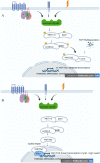Hippo signaling pathway in companion animal diseases, an under investigated signaling cascade
- PMID: 33945400
- PMCID: PMC8128184
- DOI: 10.1080/01652176.2021.1923085
Hippo signaling pathway in companion animal diseases, an under investigated signaling cascade
Abstract
The Hippo pathway is a highly conserved kinase cascade in mammals with the proteins YAP and TAZ as its most important downstream effectors that shuttle between cytoplasma and nucleus. It has a crucial role in processes such as embryogenesis, organ size control, homeostasis and tissue regeneration, where mechanosensing and/or cell-cell interactions are involved. As the pathway is associated with many essential functions in the body, its dysregulation is related to many diseases. In contrast to human pathology, a PubMed-search on Hippo, YAP/TAZ and companion animals (horse, equine, dog, canine, cat, feline) retrieved few publications. Because of its high level of functional conservation, it is anticipated that also in veterinary sciences aberrant Hippo YAP/TAZ signaling would be implicated in animal pathologies. Publications on Hippo YAP/TAZ in companion animals are mainly in cats and dogs and related to oncology. Here, we emphasize the important role of YAP/TAZ in liver diseases. First the liver has a remarkable regeneration capacity and a strict size control and the liver has a moderate liver cell renewal (homeostasis). The last years numerous papers show the importance of YAP/TAZ in hepatocellular carcinoma (HCC), hepatocyte differentiation and bile duct epithelial (BEC) cell survival. YAP/TAZ signaling is involved in activation of hepatic stellate cells crucial in fibrogenesis. The availability of drugs (e.g. verteporfin) targeting the YAP/TAZ pathway are described as is their potential usage in veterinary medicine. The aim of this overview is to stimulate researchers' and clinicians' interest in the potential role of Hippo YAP/TAZ signaling in veterinary medicine.
Keywords: Equine; Hippo pathway; YAP/TAZ signaling; canine; feline; liver; mammary gland; verteporfin.
Conflict of interest statement
The authors declare no conflict of interest.
Figures

Similar articles
-
A preliminary investigation of the role of the transcription co-activators YAP/TAZ of the Hippo signalling pathway in canine and feline mammary tumours.Vet J. 2016 Jan;207:105-111. doi: 10.1016/j.tvjl.2015.10.031. Epub 2015 Oct 23. Vet J. 2016. PMID: 26626094
-
YAP/TAZ for cancer therapy: opportunities and challenges (review).Int J Oncol. 2015 Apr;46(4):1444-52. doi: 10.3892/ijo.2015.2877. Epub 2015 Feb 5. Int J Oncol. 2015. PMID: 25652178 Review.
-
Proliferation of hepatic stellate cells, mediated by YAP and TAZ, contributes to liver repair and regeneration after liver ischemia-reperfusion injury.Am J Physiol Gastrointest Liver Physiol. 2018 Apr 1;314(4):G471-G482. doi: 10.1152/ajpgi.00153.2017. Epub 2018 Jan 11. Am J Physiol Gastrointest Liver Physiol. 2018. PMID: 29351389 Free PMC article.
-
Non-hippo kinases: indispensable roles in YAP/TAZ signaling and implications in cancer therapy.Mol Biol Rep. 2023 May;50(5):4565-4578. doi: 10.1007/s11033-023-08329-0. Epub 2023 Mar 6. Mol Biol Rep. 2023. PMID: 36877351 Review.
-
[Research advances in the role of the Hippo-YAP/TAZ signaling pathway in primary liver cancer].Zhonghua Gan Zang Bing Za Zhi. 2017 Nov 20;25(11):878-880. doi: 10.3760/cma.j.issn.1007-3418.2017.11.016. Zhonghua Gan Zang Bing Za Zhi. 2017. PMID: 29325286 Review. Chinese.
References
-
- Basu S, Totty NF, Irwin MS, Sudol M, Downward J.. 2003. Akt phosphorylates the yes-associated protein, YAP, to induce interaction with 14-3-3 and attenuation of p73-mediated apoptosis. Molecular Cell. 11(1):11–23. - PubMed
-
- Beffagna G, Sacchetto R, Cavicchioli L, Sammarco A, Mainenti M, Ferro S, Trez D, Zulpo M, Michieletto S, Cecchinato A, et al. . 2016. A preliminary investigation of the role of the transcription co-activators YAP/TAZ of the Hippo signalling pathway in canine and feline mammary tumours. Vet J. 207:105–111. - PubMed
-
- Bisso A, Filipuzzi M, Gamarra Figueroa GP, Brumana G, Biogioni F, Doni M, Cecotti G, Tanaskovic N, Morelli MJ, Pendino V, et al. . 2020. Cooperation between MYC and beta-catenin in liver tumorigenesis requires Yap/TAZ. Hepathology. 72(4): 430–1443. - PubMed
-
- Bonilla X, Parmentier L, King B, Bezrukov F, Kaya G, Zoete V, Seplyarskiy VB, Sharpe HJ, McKee T, Letourneau A, et al. . 2016. Genomic analysis identifies new drivers and progression pathways in skin basal cell carcinoma. Nat Genet. 48(4):398–406. - PubMed
-
- Brinkhof B, Spee B, Rothuizen J, Penning LC.. 2006. Development and evaluation of canine reference genes for accurate quantification of gene expression. Anal Biochem. 356(1):36–43. - PubMed
MeSH terms
Substances
LinkOut - more resources
Full Text Sources
Other Literature Sources
Research Materials
Miscellaneous
